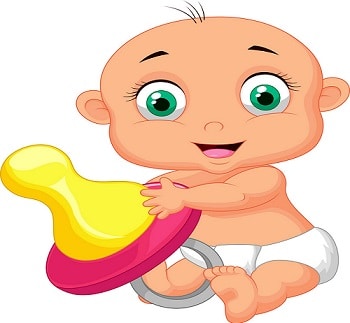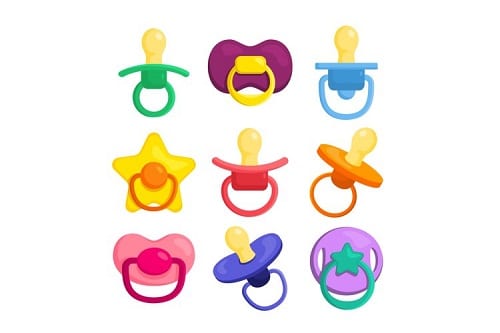When I was twenty-two years old, I wanted two things: 1. To be understood. 2. For people to think I was good at my job....Read more
The Quick answer to this question “How To Use A Pacifier ” is.
- Before using a pacifier, make sure the pacifier is clean. Wash it with soap and water and sterilize it if needed, especially for newborns.
- Hold the pacifier nipple-side up and gently insert it into your baby’s mouth.
- Babies have a natural sucking reflex. Let them latch onto the pacifier naturally. If they don’t take it immediately, don’t force it.
- Around 6 months of age, start considering pacifier weaning. Gradually reduce usage to avoid dependency.
- Regularly inspect the pacifier for any signs of wear or damage. Replace it if it’s cracked, torn, or deteriorated.
Now I will tell you in Detail about Pacifiers.

What Is A Pacifier
A pacifier is Babies can self soothe by sucking on a pacifier, which is a little device. A baby can use it as a dummy, a soother, or a binky. Pacifiers come in a variety of shapes and sizes. Newborns and younger children frequently soothe themselves by sucking on a parent’s finger or thumb. They also use a pacifier of some kind.
According to the American Academy of Pediatric Dentistry (AAPD), there is a need to satiate your baby’s demand for security and interaction. This may be linked to the use of pacifiers as well as thumb or finger sucking.
Content and security.
Baby friendly materials, including silicone, plastic, and rubber, are used to make pacifiers. They’re styled after a mother’s breasts, hence the name. Pacifiers can also be referred to as soothers. What a fantastic and fascinating development!
It has calming effects.
The soothing effects of pacifiers can be experienced by babies when they chew on a dummy. A pacifier can assist in satisfying a baby’s inborn need to chew. The infant’s natural capacity to settle down is a skill that can be improved. That’s wonderful news for your little angel baby.
How to Choose the Right Pacifier?
Consider these guidelines as you shop to choose the Right Pacifier. Simply put, form, function, and aesthetics are all crucial. The effectiveness and ease of usage are impacted by these factors.
Babies’ pacifier tastes are as varied as the babies themselves. Although your baby’s needs should always come first, we used the following guidelines to narrow down the options:
The criteria established by Drs. Kelman and Nguyen suggest designing buildings with the safety and comfort of infants in mind.
- Accessibility and cost
Overall beauty and appeal, along with durability, usability, and ease of maintenance. Parents share their experiences and insights on using pacifiers with their infants and toddlers.
- Appropriate age pacifier
Get a size that is appropriate for your kid’s age first. It ensures a snug and secure connection between the child’s gums and the Pacifier. Keeping teeth in their proper positions and ensuring adequate jaw growth can both be aided by an orthodontic plan chosen with care. This can be accomplished with the use of an orthodontic brace.
- Beware of Bisphenol-A
Cleaning up after your child will be a breeze if you choose non-BPA products, and your youngster will be safe from potentially dangerous pollutants. Design features that reduce maintenance requirements can ease the burden of parenting.
What is the correct way to use a pacifier?
When it comes to introducing a pacifier, every infant has their own preferences. What worked for an older child or a cousin, or nephew, or a friend’s newborn might not be appropriate for your new baby. Follow the steps to learn the correct way to make use of pacifiers:
- Inserting a pacifier into your baby’s mouth should be done very carefully. I dont want that little baby to go through any discomfort.
- The nipple needs to fit snugly between their lips so that they can suckle without any resistance. After All babies are the most sensitive creatures.
- Remember! Do not force the Pacifier into their mouth because doing so can be painful. Who would want a baby in pain?
Pacifier clips are a brilliant invention that prevents dirty surfaces from contaminating babies’ pacifiers. Use one of these clips to fasten the Pacifier to your baby’s clothing to assure that it won’t get lost. If you use a pacifier clip, you won’t have to waste time picking up and sanitizing dropped pacifiers any longer.
When should I give my baby a pacifier?
The question arises here at what age may I start giving my infant a pacifier? So here you go.
- The breastfeeding relationship
When you start using a pacifier is important, especially if you are breastfeeding. It’s advised to hold off until the breastfeeding relationship is stable, which usually takes three to four weeks. Before introducing any new sucking behaviors, make sure your baby is proficient at latching and nursing. Don’t forget to tell your baby ‘’I love you”.
- Talk to pediatrician
A strong breastfeeding relationship can be maintained, and nipple confusion can be avoided with this wait. You should talk to your pediatrician before giving your infant a pacifier, especially if he or she is having trouble eating. I hope you got it right!
What are the benefits of pacifiers?
Pacifiers’ benefits are listed below!
• In stressful situations, they can help parents calm fussy newborns.
• Babies often fall asleep faster with their favorite pacifier.
• Pacifiers come in many forms, sizes, and colors. Pacifiers may lessen SIDS risk, according to recent research.
• To temporarily distract the infant from an uncomfortable or distressing environment. Pacifiers may help infants sleep better, reducing SIDS risk.
Dr. Nguyen notes that “a pacifier can soothe infants and children and provide comfort during times of stress,” such as during an immunization or flight. Pacifiers soothe grownups too.
Reducing teething pain. A clean, refrigerated pacifier may soothe teething gums.
What are the disadvantages of pacifiers?
Below are the drawbacks of pacifier use:
Although there are many benefits to using a pacifier, there are also some drawbacks that should be considered.
- Misaligned teeth
Misaligned teeth and problems with the development of the palate can result from continued pacifier use, especially after the age of two.
- Overuse of a pacifier
Overuse of a pacifier can also discourage breastfeeding, which can have negative effects on a baby’s diet and eating habits. It’s important to find a happy medium between pacifier use and other fundamental facets of newborn care.
Things to avoid
- It is exceedingly unsafe to use a cord to attach a pacifier to a baby’s body or cot.
- You shouldn’t put anything sweet on a pacifier.
- If your infant is hungry, don’t give them a pacifier.
- If the infant is refusing the Pacifier, don’t make him take it.
- Don’t try to replace a pacifier with a bottle nipple.
- Avoid having your baby share a pacifier with other babies.
- Pacifiers shouldn’t be licked to clean them.
- Pacifiers should be thrown out after their use-by date.
- Avoid “novelty” pacifiers with small, removable parts that could pose a choking hazard.
A lady from a small town reported a story of her child with serious mouth infection caused by overuse of pacifiers. Please save your babies from chocking hazards because little lives matter the most!
When to Stop Using a Pacifier?
Things to remember about when to Say Goodbye to the Pacifier:
Age appropriate needs
Your baby’s need for a pacifier will change as he or she matures. Pacifiers should be phased down gradually between the ages of six and twenty-four months to reduce the risk of tooth problems.
Weaning from a pacifier should be done gradually to minimize the stress on the infant and parents throughout the transition. Your infant can make a smooth transition away from the Pacifier if you wean him or her off of it gradually.
What are the different types of Pacifiers?
There is a wide variety of pacifiers on the market nowadays to meet parents’ and babies’ individual demands.
- Orthodontic pacifiers
Orthodontic pacifiers help babies with their oral health by encouraging appropriate tongue mobility and jaw development. These shapes can reduce the likelihood of oral problems from continuous pacifier use.
- Symmetrical pacifiers
Babies who aren’t as picky about their Pacifier’s form tend to prefer symmetrical pacifiers, which feature a more conventional style. You can learn more about your baby’s preferences by trying out a variety of pacifiers.
- Open shield pacifier
Children with mouth or throat irritation can benefit substantially from using an open-shield pacifier because of the increased ventilation.
Although not specifically made for them, these are a popular choice for parents of premature or newborn infants. A conventional pacifier can be too big for young infants’ faces sometimes.
How do I properly clean a pacifier?
If you care about your child’s health and well-being, you should keep the pacifier that they use clean at all times. The accumulation of bacteria and germs could be hazardous to the health of your child. It can be avoided by maintaining a regular cleaning schedule.
To begin, wash the pacifier with a little warm water and a very little bit of mild soap. It is important to pay special attention to the nipple as well as any other fissures or crevices. They could potentially collect saliva or milk. After washing it, make sure to give the pacifier a thorough rinse to get rid of any soap residue.
Sterilizing the pacifier on occasion can help eliminate any bacteria . They may have been present despite the usual cleaning that is performed. The pacifier can be sterilized in a number of different ways, including by boiling it or by using a dedicated sterilizer.
When to Replace a Pacifier?
Let’s have a conversation about knowing when it’s time to replace your pacifier.
Pacifiers, like other infant accouterments, will become less effective over time as they age. Inspect the pacifier on a regular basis for any signs of wear and tear. Cracks, tears, or missing components can be there. It is possible that the pacifier will become less stable as your child continues to use it. It will increase the risk of suffocation.
You should replace your baby’s pacifier every two to four weeks, or sooner. Check any signs of degeneration, to guarantee your baby’s safety and good health. If you keep an eye on the condition of the pacifier, you will be able to ensure that it is clean. Check if it is appropriate for your baby to use.
What do the latest studies have to say about pacifiers?
Recent studies like The American Academy of Pediatrics and the American Academy of Family Practice recommend reducing or stopping pacifiers early,
There is research that Pacifier use beyond 12 months of age has the potential to increase the risk of ear infections in some children.
A research group from Finland stated that pacifier use is a significant risk factor for acute otitis. Their most recent study looked at the effect of parental counseling on pacifier use and the subsequent occurrence of otitis media in these children.
The intervention group received counseling on the negative aspects of pacifiers. Interestingly, at the end of the study, there were more children still using a pacifier in the intervention group than in the control group (68% versus 66.5%).
Should babies sleep with pacifiers?
There might be reasons why newborns need pacifiers at night. Many parents, in their attempt to put their infants to sleep safely and soundly, wonder if pacifiers are a good idea. While the choice is ultimately up to the individual, there are factors to think about.
Allowing infants to sleep with pacifiers has been suggested by some experts as a way to lessen the likelihood of SIDS. The Pacifier’s soothing sucking motion may facilitate a clear airway and regular breathing patterns during sleep. Following safe sleep standards is crucial for your baby’s health.
Babies should always be put to bed on their backs, and a level, firm surface should be provided. Loose blankets or toys should be removed from the room. There is no need to re-insert the Pacifier if it falls out of your sleeping baby’s mouth. Your baby’s sleep habits will change as they get older. It’s crucial to pay attention to the signs they’re giving you.
Final Thoughts
You and your baby will benefit greatly from using pacifiers and pacifier clips as part of your normal baby care routine. The comforting embrace of a pacifier can help calm a fussy baby, and a pacifier clip helps prevent any unpleasant spills from spoiling the experience.
You can give your infant the greatest care possible if you know all about the ins and outs of pacifier care. Make them choose the right one to keep it clean and germ free.

Related Articles About Kids:
- How To Label Bottles for Daycare
- How To Teach Kids About Patience
- Why Are Kids So Energetic
- How To Attract Kids Towards You
- Being Yourself Around Kids
- Why Are Kids So Loud
- Can Kids Eat Beer Battered Fish
- Why Are Hoodies So Comfortable

When I was twenty-two years old, I wanted two things: 1. To be understood. 2. For people to think I was good at my job. As a first time founder, I remember feeling under-qualified. I felt like an impostor—and it showed. I struggled to communicate my value in a way that my colleagues and potential investors could understand. I realized I needed to clarify my message and use social media as a tool to help me build my personal brand. This would help me look more credible, I thought. So I got to work. I updated my social media profiles, built a personal website, and began sharing my story online. The more content I shared, the more confident I became. And the more confident I became, the more credible I appeared. Now i am writing blogs for madeforkids.co.uk on different topics on kids.
- Latest Posts by Anna Vatuone
-
What Are The Uses Of A Drone
- -
What Are The Uses Of Playhouse
- -
How To Get A Child To Warm Up To You
- All Posts
